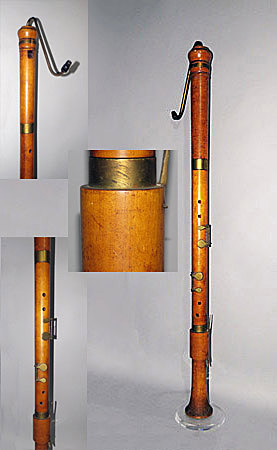
Owner: HWMC
Catalog#: 2CL-AEWF-9
Flutes - Recorders
Peter Harlan 'Contrabass' Recorder
Markneukirchen, Saxony, Germany
Peter Harlan
Maple, brass
ca. 1920’s
Length: 45.25 in, Top diameter: 3.25 in
Wind Instruments – Woodwind Instruments – Flutes – Recorders
Engraved on bottom section: Peter Harlan / Markneukirchen
Recorders were first documented during medieval times and gained popularity during the Renaissance and Baroque eras. Their popularity faded away during the Classical Era as other instruments and musical styles changed and became popular. Then in the 20th century they re-emerged.
The instrument maker Peter Harlan (1898-1966), recognized by many as the “Father of the Recorder,” played a major role in the recorder renaissance of the 20th century. In 1921, Harlan made a reproduction of a recorder with “German fingering,” instead of using cross-fingering; the right index finger simply covers a finger-hole.
During the mid-1920s Bärenreiter recognized the recorder as an important instrument in music education and contacted Peter Harlan. Harlan then started producing a range of recorders for Bärenreiter, who published tutors for music education and early music literature that led to the rediscovery of early music playing. The recorder now served as a serious artistic instrument on the one hand and a school instrument on the other.
This is a wooden contrabass recorder by Peter Harlan. It has four finger holes, a thumb hole, and five keys, four of which are round and a square key which sits lower on the instrument. The keys, as well as the three metal rings at the top and connecting sections are made of brass. There is also a matching bocal with a rubber mouthpiece.
